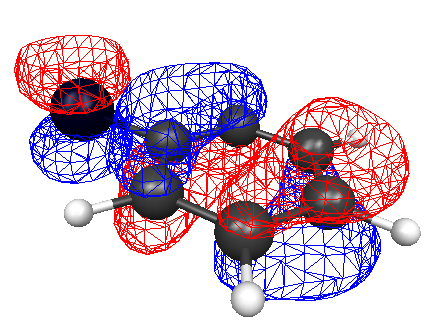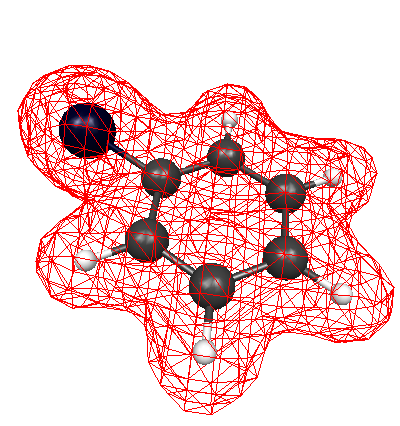
Bond Length/Order Data
| Atom-Atom
Bond |
6-31G
Bond Length (pm) |
6-31G
Bond Order |
3-21G
Bond Length (pm) |
3-21G
Bond Order |
| 1 - 5 |
1.380 |
1.419 |
1.377 |
1.372 |
| 1 - 6 |
1.380 |
1.419 |
1.377 |
1.372 |
| 1 - 7 |
1.933 |
1.071 |
1.927 |
1.062 |
| 2 - 3 |
1.388 |
1.445 |
1.384 |
1.404 |
| 2 - 6 |
1.388 |
1.453 |
1.384 |
1.410 |
| 2 - 11 |
1.073 |
.938 |
1.071 |
.934 |
| 3 - 4 |
1.388 |
1.445 |
1.383 |
1.404 |
| 3 - 10 |
1.073 |
.939 |
1.071 |
.936 |
| 4 - 5 |
1.388 |
1.453 |
1.384 |
1.410 |
| 4 - 9 |
1.073 |
.9938 |
1.072 |
.934 |
| 5 - 8 |
1.071 |
.930 |
1.070 |
.931 |
| 6 - 12 |
1.071 |
.930 |
1.070 |
.931 |
Both basis sets generated similar numbers for bond lengths and orders between the atoms in the molecule. Obviously, with such a large molecule, literature values to compare were hard to find and not available.
Orbital
Configuration

Highest
occupied molecular orbitals in
bromobenzene
More text here
Electrostatic Potential Surface
Electrostatic
potential surface of
bromobenzene
The electrostatic potential surface of bromobenzene is shown
above. Normally, bromine, as a relatively electronegative
element, would pull a bit more electron density away from an individual
carbon atom or a non-conjugated ring. However, the conjugation of
the benzene ring manages to "even out" the spread of electrons in the
molecule - there is a lot more symmetry to the distribution of
electrons as .
Calculated Vibrational Frequencies and
Motions
The vibrational
spectrum calculated by the software has many frequencies associated
with the many possible motions of the atoms in bromobenzene. The
spectrum agrees with the one found at the NIST
website. Expected absorbances due to the motions of the
benzene carbon and hydrogen were very apparent - C-H stretches around
3500 cm-1 and C-C stretches a bit above 1500 cm-1.
Back to Homepage